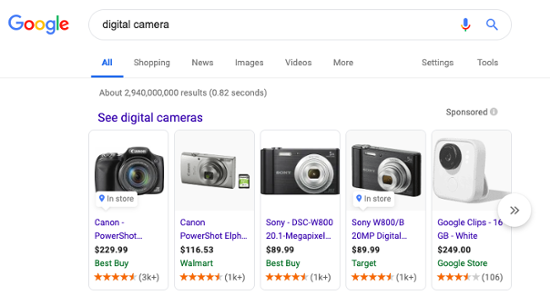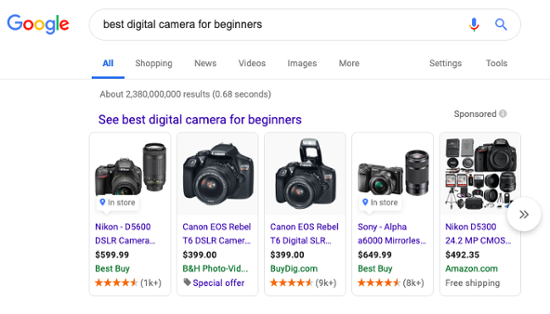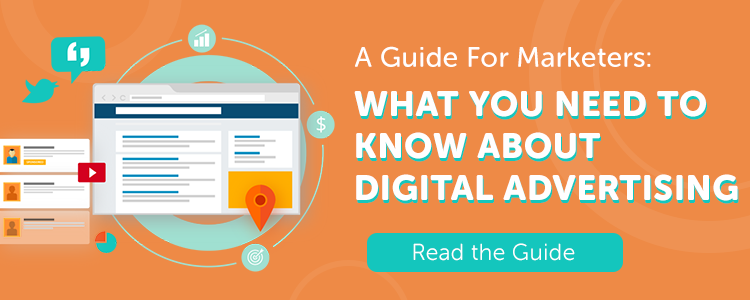Your digital advertising strategy is likely composed of a multitude of different channels through which you market your products and services. Organic traffic is always great, but it's not the only means to driving traffic and boosting engagement.
If you're looking for fast growth and immediate results, you need to add paid search to your strategy.
What Is Paid Search and How Does it Work?
Paid search advertising is a means by which businesses promote the rankings of their ads on a search engine results page or website.
It’s also known as search engine marketing (SEM), and there’s a few different ways it works – pay per click (PPC), cost per mille or cost per thousand impressions (CPM), and cost per action (CPA).
When you search for something in Google or another search engine, paid search ads are the results that appear at the very top and bottom of the results page, bookending the organic material. It often says "Ad" or "Sponsored" in small text next to or above these ads.
Now, let’s take a closer look at each of the channels of SEM, so you can understand how paid search works.
Pay Per Click (PPC)
This is the most common type of paid search advertising, so much so that the two terms are often interchanged.
With PPC ads, the advertiser pays a set amount every time a person clicks on their ad. The amount can range between 50 cents to a few dollars per click.
Cost Per Mille / Cost Per Thousand Impressions (CPM)
With this model, the advertiser pays the search engine a set amount every 1,000 times their ad appears in results.
This option is more geared toward social media ads, because it uses audiences to target people rather than keywords. It allows you to target a wider audience and ends up being a cheaper option than PPC.
Cost Per Action (CPA)
With CPA, payments are based more around metrics of success, making it in line with a key performance indictor (KPI) more than anything. The actions can be anything you want really – whether it’s submitting a form, subscribing to a blog or newsletter, registering for an account, etc.
Additionally, advertisers can leverage Google's smart bidding technologies to effectively hit CPA goals by using tCPA (target CPA) algorithms to take out the guess work and to be able to hit CPA targets.
The Benefits of Paid Search
We get it, paying for advertising is a big downer. And how do you know that you’ll get a decent ROI? It's understandable – everyone is afraid of throwing money away on a strategy that might not work.
But whether you’re a small business just starting out or a larger, more established company, using paid search advertising and a search advertising platform can benefit anyone. Its perks are pretty big hitters, boosting exposure and driving traffic to your website.
That Coveted First Page Spot
Sure, building great SEO will land you some high rankings in search results, but it’ll take you a lot of time and effort to get to that point. With paid search advertising, you land that coveted first page spot in Google’s results immediately.
Nothing boosts brand exposure and drives traffic to your website like a first page spot on Google’s results page. If you’re looking for fast results, paid search is definitely the way to go.
Higher Quality Leads
Paid search advertising drives high quality leads to your company. Your ad will only appear when Google (or any other search engines you may be advertising with) determines that it can provide a solution to what someone is searching for.
If someone clicks on your ad – whether it’s to purchase a product or enroll in a service – it’s likely that they’re pretty far along in the buyer’s journey and looking to make a purchase sooner rather than later.
Analytics for Days
If you’re using search engines like Google or Bing, they provide advertisers with detailed analytics about who is engaging with their ads and when. These details include geographical demographics, what device they used to access your site, which pages they visited, and how much time they spent on each page.
These analytics allow you to track exactly where your investment is going, assess the efficiency of your campaigns, and improve future marketing efforts for more desired results.
What to Expect When Creating a Paid Search Ad
When creating a paid search ad, you should pay attention to a number of key elements to make your campaign effective and efficient. Don’t throw your money away on sloppy, low quality ads that will perform poorly.
Follow these steps and best practices for paid search campaigns, and you’ll end up with a much greater ROI.
Set a Goal.
Before you launch your paid search ad, you need to have a goal in place for what you want to accomplish. A campaign without a specific goal can quickly become ineffective.
If you don’t know what you’re hoping to achieve, how do you know what metrics to look at, and how to analyze them? You’ll have no means to track how effective the campaign is, because you won’t know what it is you’re supposed to be tracking toward.
Are you hoping to drive traffic to your website? Generate more leads? Close sales? Boost your blog subscribers? Determine this goal first, and then you’ll be able to tell how efficient your campaign is in the long run.
Do Your Keyword Research.
It’s important to bid on the best keywords for your campaign to achieve desired results.
Focus on finding relevant keywords that have a high search volume, but low competition for ranking. Does your product or service fit into a unique niche? Target that.
Although it might seem like a good idea to bid on more general keywords so you’ll reach a wider audience, you’ll likely have more competition for these rankings.
Additionally, a campaign encompassing more general keywords is likely to procure a broad spectrum of leads, as opposed to a majority of high quality leads who are looking for a solution like yours and are ready to buy.
Ensure Relevant Ad Copy.
If you’re creating an expanded text ad, the copy that you include below the main header of your ad is incredibly important to driving engagement. If you have a strong header but ineffective ad copy, your campaign will suffer.
First of all, the ad copy needs to provide valuable information and expand upon what the header says. It also needs to be clear and engaging enough to prompt the user to click on your ad.
While you’re limited on text, use this space to provide a quick insight into what makes your product or services unique.
With that said, it’s also a good idea to have three variations of your expanded text ads, each with different copy and headers. This will allow you to track what kind of messaging is most effective with your target audience, and which receives the most engagement, so can you can create the most efficient ads possible as you move forward with future campaigns.
Geo-Target the Right Locations.
If your business is focused on specific geographic locations, make sure you stick to those areas for your ad campaign audience.
Geo-targeting random places to try and boost widespread engagement will likely result in low quality lead generation, a waste of time, and an overall waste of money.
Include a Strong CTA.
If your ad doesn’t include a strong call to action (CTA), then what’s the point of it? You need to prompt people to do something – click, subscribe, purchase, register, you name it.
A good CTA is impactful, alluring, and creates urgency within the audience to act immediately.
Examples of Great Paid Ads
There are three primary forms of paid search advertisements – shopping, expanded text ads, and display ads. Each form includes different key elements that impact the efficiency of the ad. Take a look at the examples below, and make note of what works well within each individual form.
Shopping – Focus on Niche, Long Tail Keywords
Imagine you’re a shopper looking for your very first digital camera. So what do you do? You go to Google, and you type in “digital camera” to the search engine.
The first thing that pops up are shopping advertisements. As you can see, the companies that have bid on this particular keyword are Best Buy, Walmart, Target, and Google Store.

However, notice how the results change when I adjust the search to “best digital cameras for beginners” – Amazon and B&H Photo now appear in the results.
This shows that, while Amazon and B&H Photo, BuyDig.com, and Amazon didn’t bid on the general keyword “digital camera,” they did choose to advertise for the long tail keyword “best digital camera for beginners” because they found more value in the quality of leads generated by these results.

It’s likely that customers who search for "best digital camera for beginners" are farther along the sales funnel and more likely to purchase in the immediate future, as opposed to those who simply search for “digital camera.”
With this in mind, consider which long tail keywords you might choose to focus your campaign on.
Expanded Text Ads – What’s the Message You’re Trying to Send?
Take a look at the top paid search ad that pops up when we type “paid search marketing” into Google. This ad does a number of things well.

The header of the ad asks the user a question, "Need Paid Search Marketing?" and then provides a solution – "Contact HawkSEM Today." The header of this ad directly provides a solution to fill a person's need, making it highly effective.
They then tell the user a little bit about what makes their services unique in the caption text:
“We take the time to truly understand your needs and goals. No long-term contracts. No setup fees.”
This is a prime example of high quality ad copy. The sentence describing their services is clear and concise, and they also include two quick pieces of information on the end to drive home strong selling points.
Display Ads – Emphasize The Three Keys
There are three important elements to any good display ad – quality visuals, relevant placement, and a strong CTA. These pet food display ads include all three of these core elements, which makes them highly efficient.

Firstly, each ad features a clear visual representation of the products that they’re offering. You can see that it’s pet food and what kind of pet it’s for – Purina features a dog in their ad, while Friskies features a cat.
Secondly, the ads are placed in a relevant location – these were taken off of petfinder.com, a popular website to match you with adoptable pets in your area. If you’re looking for a pet, you’ll probably need pet food to go along with it!
Therefore, the ads are clearly located on a relevant page where they are likely to receive high quality leads who are actually interested in purchasing their products.
Finally, both ads include CTAs with strong messages – Purina’s ad says “Save Now,” while Friskies actually offers you a discount with their CTA, “Get Coupon.”
Both ads are enticing, as they imply that you’ll be able to save money on pet food by clicking on them. Note that Friskies’s CTA is more impactful than Purina's because it’s larger and more prominent within the ad.
Make Sure You’ve Got Your Resources in Place
Paid search advertising can have huge benefits, but unless you’ve got the resources set up to accommodate customers when they visit your page, you’ll be wasting your money.
To get the most out of your investment in paid search advertising, make sure you’ve got your business together beforehand – that means having a well designed website, fully developed products, and readily available sales channels.
Paid search can drive traffic and bring in leads, but you'll still need to do some heavy lifting to convert those leads into sales.


Claire Cortese
I am a content creator here at Bluleadz. In my free time, I enjoy hugging dogs, watching reruns of The Office, and getting sunburnt at the beach.